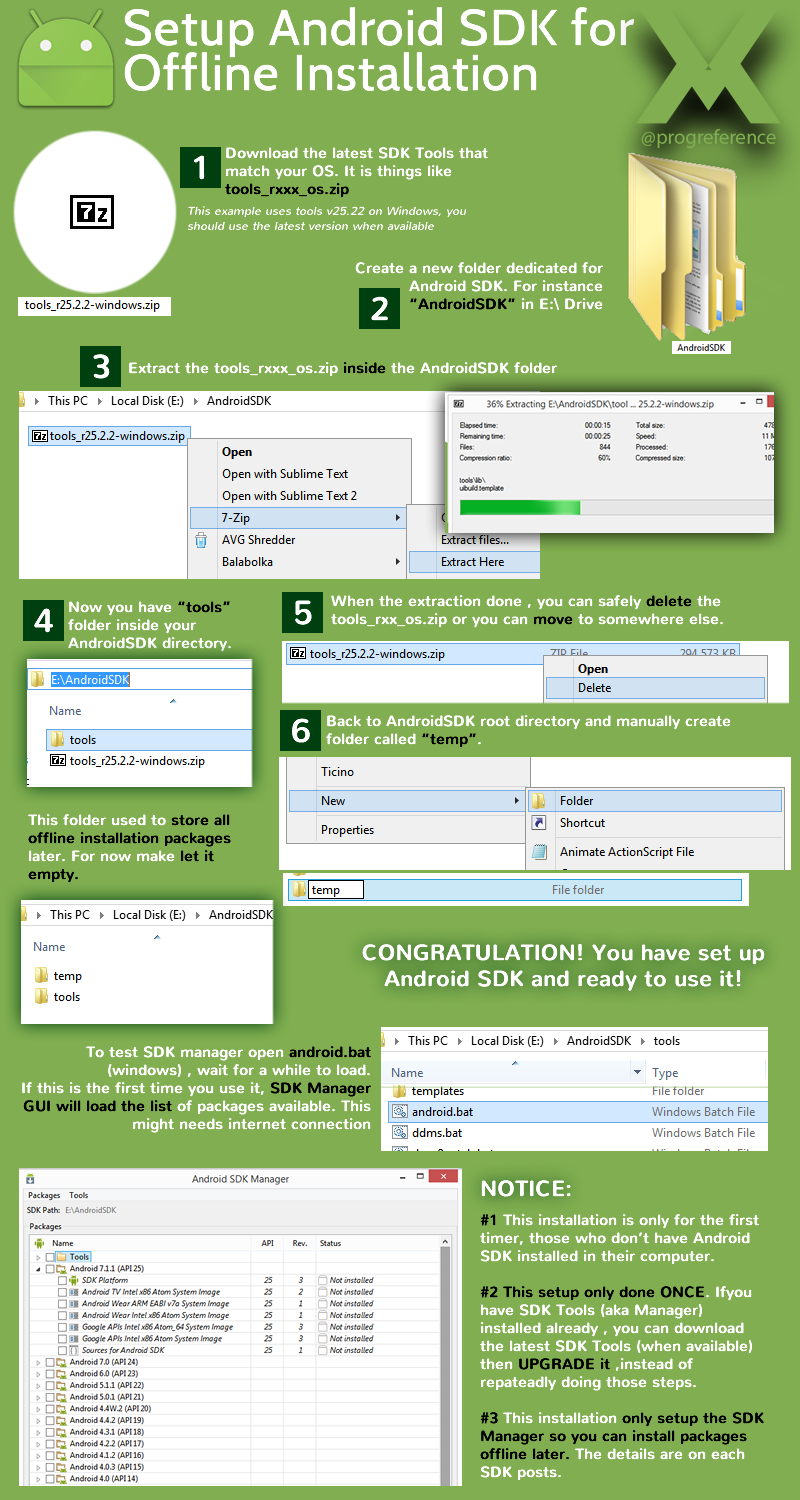Last Updated on
Android SDK 26.1.1 Released: 5th Dec 2020 (a few seconds ago) Android SDK 24.4.1 Released: 5th Dec 2020 (a few seconds ago) Android SDK 24.4 Released: 5th Dec 2020 (a few seconds ago).

With Android SDK for PC, programmers get immediate access to all the necessary tools for planning, building, testing, debugging, and profiling apps for Android. Offline documentation is provided, but you can also contact a large online community and the app developers for help, tutorials, and hint that will make your project run more smoothly. Download the latest versions of the Android Gradle plugin and Google Maven dependencies to build your project offline. Command line tools only If you do not need Android Studio, you can download the basic Android command line tools below. You can use the included sdkmanager to download other SDK packages. After you download these two files mentioned above (the SDK manager and the zip file), you can install the Android SDK on your computer without internet connection. Extract android-sdkr06-windows.zip and android-2.2r02-windows.zip. Copy or cut all files inside android-2.2r02-windows folder. Go to android-sdkr06-windows. As a mobile developer, the Android SDK is an integral part of your development environment, and as such it’s important for new developers to know how to download and install Android SDK or, the.
Android SDK is a great development kit for developer to create applications for Android platform. To use it, you have to download the Adroid SDK manager. The SDK manager let you download the rest of SDK components (which will require internet connection). So how can you install Android SDK on computers that have no internet connection? This step by step guide will help you.
Important: All files must be downloaded first before we install it on a computer without internet connection. This works well in deployment environments where all files would be downloaded to one storage device and then moved to be installed on computers without internet connections.
1. Download the SDK manager. We won’t use it to download any components. We need it to lauch the emulator later.

2. Lauch your browser and go to http://dl-ssl.google.com/android/repository/repository.xml
3. Quicky find the android platform that you want to download by pressing Ctrl+F ( In FireFox), we want to find the latest Android platform 2.2 so we typed in: 2.2
Other available platforms: 2.1, 1.6 and 1.5
As you can see from the picture below, we have zip files for Linux, Mac osx and Windows. Highlight the part: android-2.2_r02-windows/linux/macosx.zip and copy it.
Note: We can use this trick to download future Android platform ( 2.3, 3.0….)
4. Paste what you have copied right after http://dl-ssl.google.com/android/repository/ and we will have the direct link to download the Android 2.2
5. After you download these two files mentioned above (the SDK manager and the zip file), you can install the Android SDK on your computer without internet connection.
6. Extract android-sdk_r06-windows.zip and android-2.2_r02-windows.zip.
7. Copy or cut all files inside android-2.2_r02-windows folder.
8. Go to …android-sdk_r06-windowsandroid-sdk-windowsplatforms and creat a new folder (You can name it anything you want, we named it android 2.2)
9. Paste all your copied/cut files to that folder (in this post is: android 2.2)
10. Lauch ….android-sdk_r06-windowsandroid-sdk-windowsSDK Setup.exe
Android Sdk Download Exe
11. The SDK and AVD Manager will autodetect the SDK Platform.
12. Go to Virtual Devices and click on New to create a new android virtual device.
13. A new window will pop up, you can name your device, choose target, set size for SD card, choose skin. Click on Creat AVD to create your device.
14. Click on Start to lauch your virtual device.
About Lê Hoàng
View more articles by Lê Hoàng
The Conversation
Follow the reactions below and share your own thoughts.
Android SDK is a software development kit, that enables apps developers to create applications/games for the Android platform. Sample projects are included in Android Software Development Kit with source code. The SDK also includes, development tools, an emulator, and required libraries to build Android applications. Applications can be written by using the Java programming language and run on Dalvik, a custom virtual machine designed for embedded use which runs on top of a Linux kernel.
System Requirements for Android SDK Installation

Android Sdk Full Download Offline Version
1- Supported Operating Systems for Android SDK
- Windows XP (32-bit), Vista (32- or 64-bit), or Windows 7 (32- or 64-bit)
- Mac OS X 10.5.8 or later (x86 only)
- Linux (tested on Ubuntu Linux, Lucid Lynx)
- GNU C Library (glibc) 2.7 or later is required.
- On Ubuntu Linux, version 8.04 or later is required.
- 64-bit distributions must be capable of running 32-bit applications.
2- Supported Development Environment for Android SDK
Eclipse IDE
- Eclipse 3.6 (Helios) or greater
Note: Eclipse 3.5 (Galileo) is no longer supported with the latest version of ADT. - Eclipse JDT plugin (included in most Eclipse IDE packages)
- Several types of Eclipse packages are available for each platform. For developing Android applications, we recommend that you install one of these packages:
- Eclipse IDE for Java Developers
- Eclipse Classic
- Eclipse IDE for Java EE Developers
- JDK 5 or JDK 6 (JRE alone is not sufficient)
- Android Development Tools plugin (recommended)
Note: If JDK is already installed on your development computer, please take a moment to make sure that it meets the version requirements listed above. In particular, note that some Linux distributions may include JDK 1.4 or Gnu Compiler for Java, both of which are not supported for Android development.
2- Recommended Hardware Requirements for Android SDK
- Minimum 2 GBs of RAM
- Intel Core2Due or equel Processor for x86 Architechure
- 4 GB Hard Disk Space

Comments are closed.